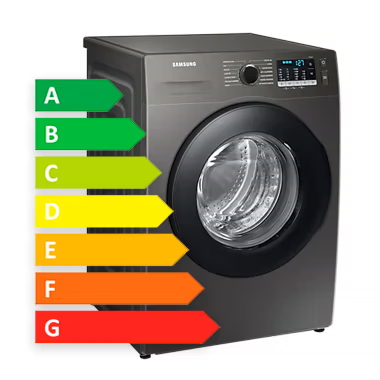
And when it comes to quickly identifying the most efficient machines amid the vast array of brands and models available, nothing beats checking the energy rating on the energy label!
This letter-and-colour grading system lets you instantly gauge whether a washing machine is energy-efficient and high-performing, or simply a power guzzler.

But a word of caution!
Before you zero in on models boasting the top energy ratings, it’s vital to understand what these ratings really mean, how they’re calculated, and which one you should prioritise for your new machine.
To help with your research, we’ve put together this comprehensive buying guide covering everything you need to know about the energy efficiency rating and energy label on washing machines.

A washing machine’s energy rating reflects its efficiency relative to the standards set by regulations.
It is divided into seven grades (A, B, C, D, E, F, G), with A representing the best and G the least efficient.
Each grade is also assigned a colour, ranging from green for the best ratings to red for the poorest.

This simple letter-and-colour system allows you to quickly distinguish between high-performing, energy-saving machines and those that consume more power.
Manufacturers and retailers often use this visual classification to promote the most economical models in their range.

A quick visit to online appliance retailers will reveal a wide variety of washing machines with differing energy ratings – from A for premium models to E or F for budget-friendly options.
This means you can genuinely choose a model that suits both your environmental ethos and your budget – a refreshing change compared to the fridge and freezer markets, where nearly every model is rated D, E or F.
However, a word of caution!
We strongly advise against focusing solely on the energy rating when deciding which washing machine model to choose.
Why?
Simply because there are several other equally important – if not more crucial – factors to consider when selecting your new washing machine:

If you have a look at our Top Picks of the Best Washing Machines of 2025, you’ll notice that most models carry energy ratings of A or B.
That’s excellent news – it shows that today’s models are impressively efficient and energy-saving.
That said, a B or C rating doesn’t automatically mean it’s a bad choice for your new washing machine.
For instance, if you regularly tackle large loads of laundry, opting for a 10 or 11kg model with a B energy rating is a far better option than choosing a smaller, 7 or 8kg A-rated machine.
In short, the key to choosing a new washing machine is finding the right balance between energy efficiency and all the other important factors mentioned above. ;)
Please Note: To help you in your search, do check out our top picks and buying guides for the different types of washing machines available on the market – they’re sure to help you find the perfect model:
➤ Best Washing Machines 2025: Top Picks, Reviews & Testing
➤ Best Washer-Dryers of 2025
➤ Best Large-Capacity Washing Machines of 2025
Here’s what you’ll find on a washing machine’s energy label:


The most prominent element on the energy label is the energy rating – a feature that manufacturers and retailers proudly showcase to promote their “eco-friendly” models.
But what does it actually represent?
How are the various letters and colours assigned to new washing machine models determined?
It all starts with British legislation.
According to the regulations on energy labelling for household washing machines, every new machine must obtain an Energy Label before it can be sold.
To achieve this, machines undergo a series of tests to determine their Energy Efficiency Index (EEI).
Among these tests is a detailed analysis of energy consumption, taking into account different loads – whether the drum is full, half-full, quarter-full, etc.
Once all the tests are complete and the data gathered, it is fed into a specific mathematical formula:|

Don’t worry, we won’t get bogged down in the details… ;D
After calculating the EEI, manufacturers then use a conversion table – “Energy Efficiency Index => Energy Efficiency Class” – to assign the final rating to the appliance.

Only after these steps is the energy label finalised and the machine approved for sale.
As you can see, opting for a washing machine with a good energy rating is a wise move, but we wouldn’t recommend making it your sole selection criterion.
In our view, capacity is far more important as it directly affects the number of wash cycles you’ll need, which in turn influences your water and electricity consumption.
To find the ideal washing machine, you’ll need to choose a model that perfectly matches your needs in terms of capacity and available programmes, fits within your budget, and still boasts a solid energy rating. ;D
We hope this buying guide on washing machine energy ratings and the energy label helps you make an informed decision.
Best of luck, and we look forward to seeing you again on ApplianceReviews.co.uk!
Below you’ll find all our reviews, top picks and buying guides to help you discover everything you need to know about washing machines:
➤ Best Washing Machines 2025: Top Picks, Reviews & Testing
➤ Best Washer-Dryers to Buy in 2025: Top Picks & Reviews
➤ Best Quiet Washing Machines: Testing & Top Picks 2025
➤ Best Large Capacity Washing Machines [12kg+] – Testing & Top Picks 2025
➤ Are BEKO Washing Machines any Good? Review & Top Picks
➤ Are BOSCH Washing Machines any Good? Review & Top Picks
➤ Are LG Washing Machines any Good? Review & Top Picks
➤ Are SAMSUNG Washing Machines any Good? Review & Top Picks
➤ Are MIELE Washing Machines any Good? Review & Top Picks
➤ Are AEG Washing Machines any Good? Review & Top Picks